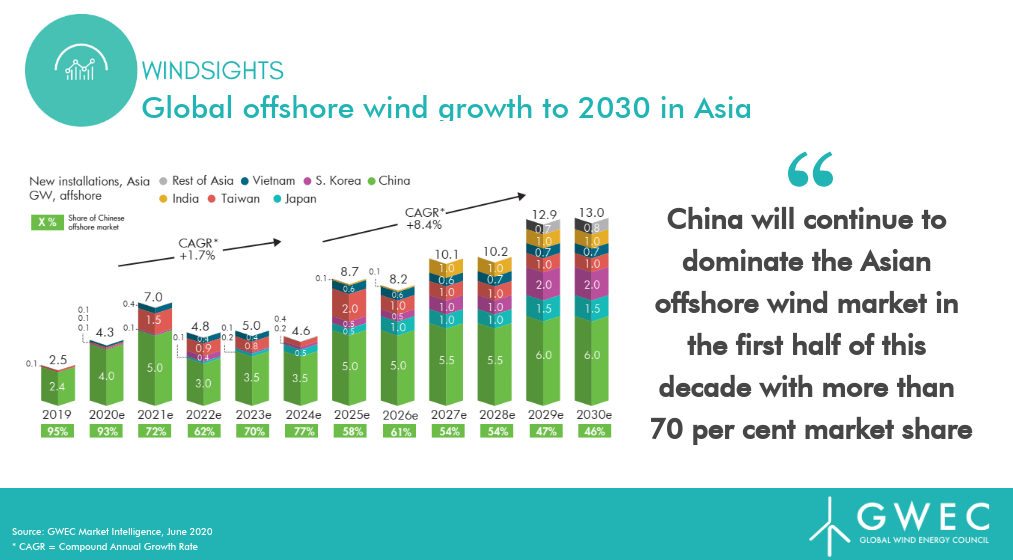The Rise of Wind Power in Asia 2022
Wind Turbines in Yunnan province, China.
12 May 2022 – by Eric Koons Comments (0)
Onshore Wind Farms in Asia
Asia produced 34.5% of the world’s total wind energy in 2018. China led with 28%, and India accounted for 5%. A vast majority of this came from utility-scale wind power plants. For example, two utility-scale wind power plants are in China and Japan. In the Gansu province, China, the wind farm was responsible for producing 7.8 gigawatts (GW) of wind energy. In Japan, the Shin Izumo onshore wind farm produced up to 78 megawatts (MW).
Power-generating Wind Farm in Southeast Asia
Wind farms are also popping up across other parts of Asia, including Southeast Asia. However, a significant portion of its potential is still lacking. According to recent data, Southeast Asia could realise up to 8.9 GW of wind power capacity by 2030. Many projects are already in the works.
For example, in South Korea, the Ulsan Offshore Wind Complex will be the world’s largest floating offshore wind project. It will have 1.5 GW in energy generation capacity. In Vietnam, the Thang Long Wind Project will be the country’s largest offshore wind power plant, with a 3.4 GW capacity.
The Future of Wind Power in Asia
If projections and growth remain constant and accurate, Asia could see a nine-fold increase in wind power by 2050. This would equal 613 GW of offshore and 2,646 GW of onshore wind power spread across Asia.
However, the annual investment would need to average between USD 61 billion to 211 billion to achieve these numbers. With the industry poised for growth, it presents significant investment opportunities for not only wind energy but related industries. For example, project developers, operations managers and power generation and transmission facilities all benefit.
Asia’s overall capacity for onshore and offshore wind power positions it perfectly to become a dominant region for renewable energy generation. Established projects, along with future developments, showcase innovation and the ability to scale on a country level.
Additionally, Asia’s onshore and offshore wind projections indicate a high level of commitment focused on renewable energy. This is critical as the globe moves towards net-zero goals and phasing out fossil fuels, including coal, oil and gas. Overall, the rollout of renewables across Asia, including wind, will bring about investment opportunities and economic, health, and planetary benefits.

What Is Wind Power?
Wind power or wind energy is kinetic energy that is generated by the wind as it moves. A wind turbine converts the wind energy into mechanical and eventual electric power.
How Do Wind Power Plants Work?
Wind power plants capture this kinetic energy using rotating wind turbines and convert it into mechanical energy. Then generators convert the mechanical energy into electricity, which goes into the power grid.
Types of Wind Power Plants
There are three main types of wind power plants: utility-scale, distributed (small), and offshore wind that capture wind energy. Offshore wind turbines generate the most electricity, averaging 4,000 kilowatts (KW).
Differences in Wind Turbines
Onshore and distributed wind turbines are typically much smaller and average 2,000 and 1.6 kilowatts, respectively. The efficiency of wind turbines is relatively high compared to solar energy. The theoretical Betz Limit of 59 percent is the maximum efficiency possible however, most turbines average 50 percent.
by Eric Koons
Eric is a passionate environmental advocate that believes renewable energy is a key piece in meeting the world’s growing energy demands. He received an environmental science degree from the University of California and has worked to promote environmentally and socially sustainable practices since. Eric’s expertise extends across the environmental field, yet he maintains a strong focus on renewable energy. His work has been featured by leading environmental organizations, such as World Resources Institute and Hitachi ABB Power Grids.
Read more



